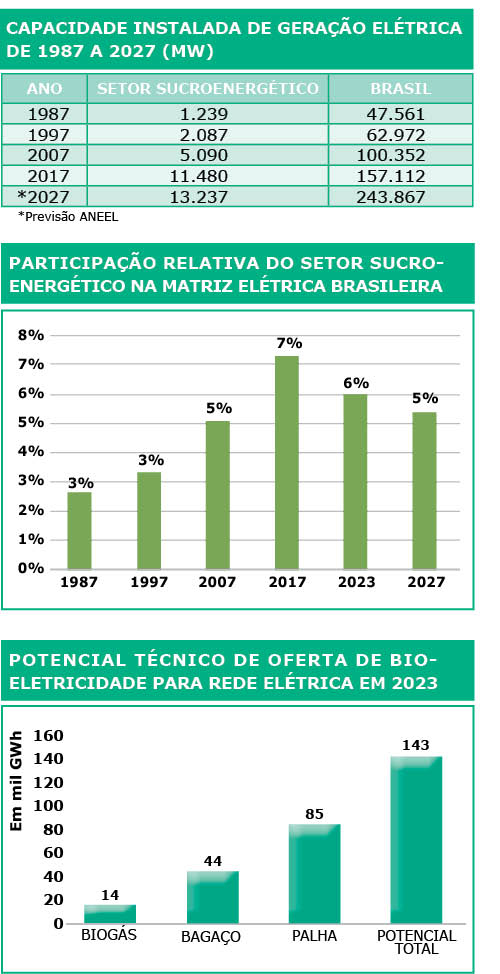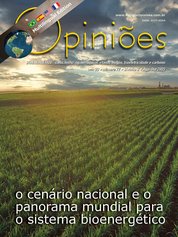Jairo Menesis Balbo e Zilmar José de Souza
Diretor Industrial na Usina São Francisco e Gerente de Bioeletricidade na UNICA, respectivamente
OpAA77
As evoluções do setor produtivo industrial: a bioeletricidade e o biogás
Desde meados da década de 1980, o Brasil usa a cana-de-açúcar para produzir bioeletricidade para o Sistema Interligado. Em 1987, a Usina São Francisco, do Grupo Balbo, foi a primeira a exportar energia elétrica obtida da biomassa da cana para a CPFL Energia, empresa distribuidora de energia. Em seguida, a usina São Martinho, de Pradópolis-SP, e a Vale do Rosário, em Morro Agudo-SP, hoje ligada à Raízen, também iniciaram a atividade de venda de excedentes à rede nacional. Essa é uma história de pioneirismo que merece sempre ser lembrada pelo esforço das pessoas e instituições à época.
Segundo o Ministério de Minas e Energia, 1970 e 2000, a geração de energia elétrica pela biomassa, dominada pelo setor sucroenergético e de papel e celulose, contribuiu para a produção total no país de eletricidade em torno de 2% de participação. Porém, a partir do ano 2000, a biomassa ganhou relevância, com taxas superiores de crescimento a 10% a.a., elevando sua participação na matriz elétrica de 2% para 8%.
 Em 1987, o setor sucroenergético detinha apenas 1.239 MW instalados, representando 3% da matriz elétrica brasileira. Dez anos depois, havia crescido para 2.087 MW instalados, mas representando ainda 3% da matriz elétrica brasileira. O grande salto viria nas duas décadas seguintes:
Em 1987, o setor sucroenergético detinha apenas 1.239 MW instalados, representando 3% da matriz elétrica brasileira. Dez anos depois, havia crescido para 2.087 MW instalados, mas representando ainda 3% da matriz elétrica brasileira. O grande salto viria nas duas décadas seguintes: • no período 1998-2007 cresceu 144% em relação a 1997, atingindo 5.090 MW instalados em, enquanto a matriz elétrica brasileira cresceu 59% no mesmo período;
• no período 2008-2017, quando chegou a 11.480 MW instalados, representando um crescimento de 126% em relação a 2007, enquanto a matriz elétrica brasileira cresceu 57% no período.
A participação do setor sucroenergético na matriz elétrica brasileira, no período de 1987 a 2017, resultou em crescimento importante também. De 3% de representação na matriz elétrica ao fim de 1987 e 1997 cresceu para 5% no fim de 2007 e 7% de representação em 2017.
Atualmente, o setor sucroenergético detém 12.359 MW instalados em potência outorgada pela ANEEL (mais do que uma usina Belo Monte), com a representação na matriz elétrica brasileira atingindo 6% e 72% de toda a potência instalada pela fonte biomassa em geral no país.
Segundo a ANEEL, de 2023 a 2027, a fonte biomassa a partir da cana deverá acrescentar novos 878 MW à matriz elétrica brasileira, fazendo com que o setor sucroenergético chegue a 13.237 MW em 2027.
Espera-se que esse acréscimo de novos MW vindos do setor sucroenergético, na base de dados da ANEEL, seja alterado e incrementado com novos projetos até 2027, conforme avançamos na linha de tempo e na melhora do ambiente institucional no setor elétrico e sucroenergético. Caso se confirme esse número de novos MW, o setor sucroenergético terá crescido 7% entre 2017 e 2027, enquanto a matriz elétrica crescerá 25%. A fonte biomassa da cana cairá de uma representação relativa de 7% em 2017 na matriz elétrica brasileira para 5% em 2027.
A biomassa em geral (incluindo todas as biomassas) chegou a representar 32% do crescimento anual da capacidade instalada no país: em 2010 foi instalado um total de 1.750 MW novos pela fonte biomassa, mostrando o potencial de resposta rápida por parte dessa fonte de geração.
Os números atuais, até 2027, mostram que não houve paralisia de investimentos no setor da bioeletricidade nos anos recentes, ao se continuar acreditando na atividade de geração de bioeletricidade para a rede, mas há uma retração na representatividade do setor sucroenergético na matriz elétrica brasileira, que esperamos seja revertida nas próximas décadas, considerando o potencial existente desse setor.
Segundo a EPE, em dezembro de 2022, um total de 236 unidades sucroenergéticas comercializava energia elétrica para a rede (aproximadamente 70% do total de usinas em operação). Em 2023, o potencial técnico de geração de bioeletricidade para a rede é estimado em 143 mil GWh, equivalente a mais de duas vezes a geração da usina Itaipu no ano passado.
Até 2032, com crescimento de 21% em relação a 2023, o potencial técnico de bioeletricidade no setor sucroenergético poderá chegar a 173 mil GWh, equivalente a mais do que o consumo de todo o Estado de São Paulo em 2022, conforme estudo da UNICA com base em dados do Plano Decenal de Expansão de Energia 2032 (PDE 2032).
Com referência ao biogás para produção de eletricidade e de biometano, é importante o aproveitamento da vinhaça, sempre respeitando a diretriz de que não se deve pensar somente na produção de energia, mas também na condição do digestato resultante do processo, aprofundando-se em estudos que tratem de avaliar e garantir a qualidade do biofertilizante orgânico que retorna aos canaviais, o qual representa o principal ativo de uma usina sucroenergética.
A EPE (2022) considera que o setor sucroenergético tem potencial técnico de exportação de bioeletricidade (a partir da vinhaça e torta de filtro) saindo de 14 mil GWh em 2023 para 17 mil GWh em 2032, equivalente a 11% do consumo residencial de eletricidade ou a 46% da geração do Complexo Belo Monte no ano passado.
Enfim, passados 36 anos do início da geração para o Sistema Interligado em usinas sucroenergéticas de bioeletricidade, ainda há muito trabalho a ser feito e evoluir no nosso setor produtivo, além de um grande potencial em investimento e na expansão da oferta dessa energia renovável e sustentável para a rede. Tão inspiradas e dedicadas como foi a geração dos pioneiros na bioeletricidade, novas gerações estão vindo e virão para ajudar a cumprir esse desafio do aproveitamento do potencial da bioenergia presente no setor produtivo canavieiro. Trabalhemos!




